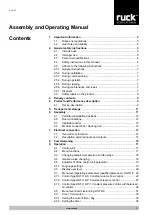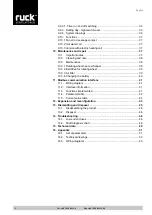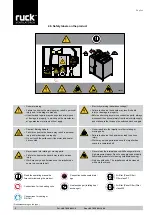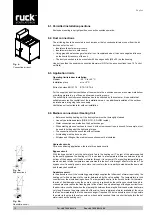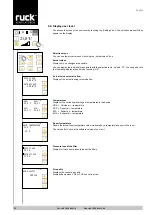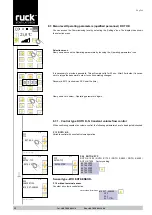
11
English
Fig. 3:
Unit transported on a pallet with
a forklift.
5. Transport and storage
6. Assembly
Transport and storage should only be performed by specialist personnel in accordance with the installation
and operating manual and regulations in force.
The following points should be noted and followed:
•
Check the delivery according to the delivery note to ensure it is complete and correct and check for
any damage. Any missing quantities or damage incurred during transport should be confirmed by the
carrier. No liability is accepted if this is not observed.
•
The product weighs approx. 200 - 650 kg (depending on the product type in question).
For weight see technical data
•
It should be transported with suitable lifting equipment in the original packaging or on the transport
equipment indicated.
•
If transported with a forklift it should be ensured that the product is resting with the basic profile or
base frame completely on the forks or on a pallet and the product’s centre of gravity is between the
forks (see Fig. 3).
•
The driver must be authorized to drive a forklift.
•
Do not go beneath the suspended load.
•
Only lift and transport the machine by its base plate, never by the cover handle!
•
Avoid damage or deformation of the housing.
•
The product must be stored in a dry area and protected from the weather in the original packaging.
Open pallets should be covered with tarpaulins. Even weatherproof modules should be covered
because their weather resistance is only guaranteed after complete installation.
•
Storage temperature between –10 °C and +40 °C. Avoid severe temperature fluctuations.
•
If the product has been in storage for more than a year, check the smooth running of impellers and
valves by hand.
Assembly work may only be performed by specialist personnel in accordance with the installation and
operating manual and the regulations and standards in force.
The following points should be noted and followed:
•
The foundation must be even and levelled. It must not exhibit unevenness or a slope in any direction.
•
Suitable foundations are: full foundation in concrete, strip foundations or steel bearer structures. In the
case of strip foundations and steel structures, it must be ensured that the machine base sits fair and
square on the bearers. Steel structures must be sufficiently rigid for the size of the machine.
•
Set up and align the machine with the aid of a water level. Only if the machine is horizontally installed
can proper condensate drainage be guaranteed.
•
Only suitable installation aids, in accordance with regulations, should be used.
•
The installation should be easily accessible for maintenance and cleaning and should be easy to
dismantle.
•
The unit should only be installed with authorized and suitable fastening materials at all fastening
points.
•
Do not distort the unit when installing.
•
The unit should be suitably secured.
•
No holes should be made in the housing, or any screws screwed into it.
•
The duct system must not be supported on the housing.
•
It is recommended that the duct system is attached with flexible connections in order to isolate any
structure-borne noise.
•
Make sure that the duct system cannot be closed off.
•
Make sure that the intake duct has direct access to the intake air.
Warning: branches in the intake duct, to other fan units for example, may, if the dimensions
are too small, lead to low pressure in the duct and therefore malfunction of the unit.
•
The pressure loss in the duct system must not be more than the capacity of the unit! The pressure
loss in the duct should not be more than 2/3 the unit’s maximum pressure so that an adequate air
output can still be achieved. This will prevent malfunction. Pressure losses in the duct system are ad
-
versely affected by: the length of the duct system, small duct cross-section, elbows, additional filters,
valves, etc.
www.ruck.eu



